This study will reveal the meaning of the symbols, statues and attire used by the Pope and priests, as they reveal what the Papal Church is really worshiping.
For thousands of years Pagan religions have used symbols to show which gods they worshiped. These symbols were declared openly in Egypt, Babylon, Rome and other cultures.
These symbols are still used today, but their true meanings are hidden. Most people typically don’t notice the symbol or they have a positive impression of it.
The enlightened understand the meaning behind the symbols, and they use them to communicate with others.
Leaders of a Christian Church should not have anything to do with the symbols of pagan gods.
“For what fellowship has righteousness with lawlessness? And what communion has light with darkness? And what agreement has the temple of God with idols? For you are the temple of the living God.” 2 Corinthians 6:14,16
If you’re Catholic, ask yourself why the leaders of the Roman Catholic Church are using all of these symbols of pagan gods.
The Zucchetti which is worn by Catholic priests, cardinals and the Pope, represents respect, fear and submission to Cybele, the Mother Goddess of Rome.
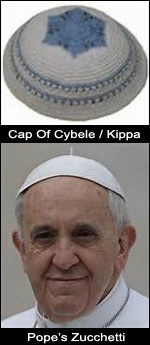 The Cap of Cybele is one of the oldest and most sacred pagan religious symbols of humanity, dating back to 2,000 B.C.
The Cap of Cybele is one of the oldest and most sacred pagan religious symbols of humanity, dating back to 2,000 B.C.
The skull cap was worn by the sun priests of Egypt.
It is a thin, slightly rounded skullcap now commonly known by various titles including the Yarmulke (Jewish) and Kufi (Muslims).
The Roman Catholic Church calls it the Zucchetti.
Vatican Hill was the site of the largest ancient temple to Cybele. Ashtoreth the goddess of fertility, sexuality and war; was known as Cybele in Rome.
The Bible warns against worshiping her, “Then the children of Israel again did evil in the sight of the LORD, and served the Baals and the Ashtoreths.” Judges 10:6
The Bible declares “For a man indeed ought not to cover his head, since he is the image and glory of God.” 1 Corinthians 11:7
Ask yourself, why do Catholic priests, Bishops and the Pope, wear the Cap of Cybele?
The Mitre hat that is worn by Catholic priests, cardinals and the Pope, represents Dagon the Babylonian fish god.
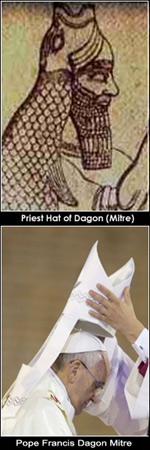 The ancient Babylonians worshiped Dagan, the god of agriculture, plenty (food) and good fortune.
The ancient Babylonians worshiped Dagan, the god of agriculture, plenty (food) and good fortune.
The Babylonian priests wore a headdress that represented the worship of Cybele and Dagon. It featured an open-fish mouth on the head, with the rest of the fish body forming a cloak.
In the Roman Empire, it was worn by the head priest of Cybele (the Magna Mater) or the Great Queen Mother Goddess.
Today the Catholic Cardinals, Bishops and the Pope all wear the open fish-mouth mitre, which represents the worship of Cybele and Dagon.
The Mitre hat of Dagan is always worn over the Kippa of Ashtoreth/Cybele, as you can see in the picture of Pope Francis I.
God warned the Jews not to worship the gods of Babylon, ” I will pronounce My judgments on them concerning all their wickedness, whereby they have forsaken Me and have offered sacrifices to other gods, and worshiped the works of their own hands.” Jeremiah 1:16
Ask yourself, why do Catholic Cardinals, Bishops and the Pope, all wear the mitre of Dagan?
The Obelisk in St. Peter’s Square represents the worship of the Sun god.
 Obelisks were prominent in the architecture of the ancient Egyptians, who placed them at the entrance of a temple, marking it as a zone of sun worship.
Obelisks were prominent in the architecture of the ancient Egyptians, who placed them at the entrance of a temple, marking it as a zone of sun worship.
They represent the Sun God Ra, the Egyptians’ greatest deity; the creator of humanity, the source of all heat and light, the being on which man was totally dependent.
An Egyptian obelisk sits in front of the Pantheon of ancient Rome, which housed statues of their pagan gods. The obelisk was originally constructed by Pharaoh Ramses II for the Temple of Ra in Heliopolis. It was brought to Rome in ancient times where it was used near a shrine to the Egyptian god Isis.
The Pantheon was dedicated to pan theos, meaning “all the gods.” When it became a Roman Catholic Church, it was dedicated to the Virgin Mary and all the martyrs.
The most well-known Egyptian obelisk was re-erected in 1586 A.D., in front of St. Peter’s Basilica. It is surrounded by a sun wheel, with the points lining up with the Vernal Equinox, the Summer Solstice and the Winter Solstice.
.
During the sunrise on the Vernal Equinox, the sun causes the obelisk to cast its shadow towards the dome of St. Peter’s Basilica, which represents the sexual union of the sun god and moon goddess.
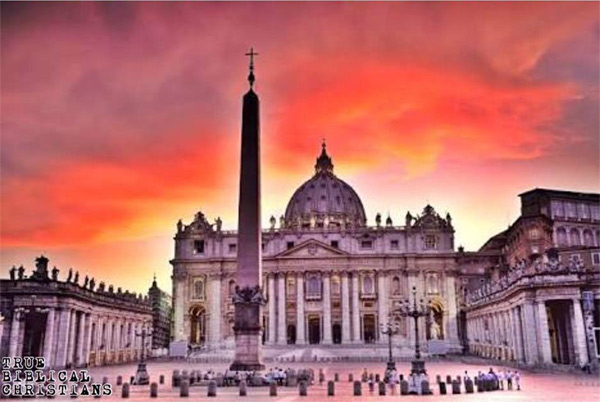
God’s 2nd commandment says, “You shall not make for yourself a carved image, or any likeness of anything that is in heaven above, or that is in the earth beneath, or that is in the water under the earth; you shall not bow down to them nor serve them. For I, the Lord your God, am a jealous God.” Exodus 20:4-5
Ask yourself, why does the Catholic Church venerate pagan monuments to the Sun god?
The six-sided star is the supreme symbol of Satanic tyranny.
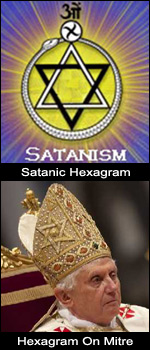 The hexagram has been used by people such as the pagan Babylonians, Egyptians and Assyrians, to directly or indirectly worship Satan.
The hexagram has been used by people such as the pagan Babylonians, Egyptians and Assyrians, to directly or indirectly worship Satan.
Helena Blavatsky wrote that “Lucifer is the true God“, and she incorporated the hexagram in the emblem of the Theosophical Society, which she founded in 1875.
Satanists, Luciferians, astrologers and witches use it to invoke the power of demons.
The six-sided star numerically equals 666 (6 points, 6 triangles, 6-sided hexagon).
Christians pass it off as the ‘Star of David‘ but the truth is that King David never used a star, so calling it a nice sounding name hides what it really represents. King Solomon used it in witchcraft, magic and idolatrous worship to Ashtoreth and to Moloch.
Stephen accused the Jewish leaders, “And you took up the tent of Moloch, and the star of your god Remphan, the figures which you made” “in order to worship them.” Acts 7:43
Ask yourself, why does the Catholic Church use the Satanic six-sided star?
The eight-pointed star represents the pagan goddess Ishtar, the lightbringer.
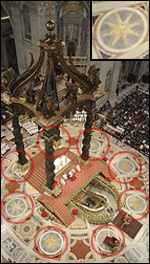 In Babylonian symbolism, the goddess Ishtar is represented by an eight-pointed starburst, and she is associated with the planet of Venus.
In Babylonian symbolism, the goddess Ishtar is represented by an eight-pointed starburst, and she is associated with the planet of Venus.
Ishtar was the Babylonian High-Mother-Goddess, the goddess of fertility, love and war. Her cult was the most important one in ancient Babylon.
An eight-point star enclosed within a circle is the symbol for the sun god, as it’s points represent the solstices and equinoxes.
The “Babylonian star-cult is the core and the archetype of subsequent astrology.”
At the center of St. Peter’s Basilica, the Pope sits in the middle of eight 8-sided stars.
Ask yourself, why does the Catholic Church use the eight-pointed star of Ishtar?
The Maltese Cross represents Shamash, the god of the Sun and Justice.
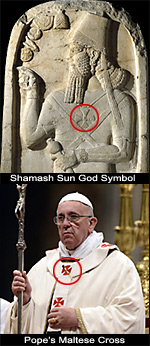 In the image, an ancient Assyrian king is wearing a cross on his chest, just like the one seen on the Pope’s robe.
In the image, an ancient Assyrian king is wearing a cross on his chest, just like the one seen on the Pope’s robe.
Shamash (Akkadian Šamaš “Sun”), was a native Mesopotamian deity and the sun god in the Akkadian, Assyrian and Babylonian pantheons.
Shamash was the god of justice in Babylonia and Assyria, corresponding to Sumerian Utu.
This cross was identified with a Sun god eight centuries before Christ and long before it was called the Maltese Cross by the Knights of Malta.
It’s also called the Iron Cross. Roman Catholic Adolph Hitler renewed use of the Iron Cross in 1939 and superimposed the Nazi swastika in its center.
Ask yourself, why does the Pope wear the cross of Shamash the Sun god?
Pine cones symbolize the worship of the solar god Osiris.
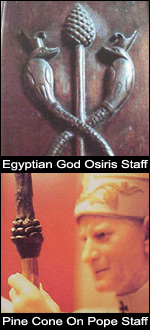 Pine cones are associated with spiritual enlightenment by ancient Babylonians, Egyptians and Greeks. They represent the mysterious link between the physical and the spiritual worlds, which can be found in the human brain, in the pineal gland.
Pine cones are associated with spiritual enlightenment by ancient Babylonians, Egyptians and Greeks. They represent the mysterious link between the physical and the spiritual worlds, which can be found in the human brain, in the pineal gland.
The pine cone staff is a symbol of the solar god Osiris and originated in Egypt where he was their messiah who died for his people and whose Mother, Isis, was worshiped as the Virgin Mother.
The Vatican also has the world’s largest pine cone that once decorated a fountain in ancient Rome next to a vast Temple of Isis.
At the Old St. Peter’s Basilica, it was dedicated to Attis, son and lover of Cybele. The Catholic Church then relocated it to what’s now called the Vatican Court of the Pigna.
Ask yourself, why do Popes use pine cones which symbolize the solar god Osiris?
Revelation 13 says that Satan the dragon gives authority to the antichrist beast.
The Bible calls Satan the great dragon, who deceives the world.
“So the great dragon was cast out, that serpent of old, called the Devil and Satan, who deceives the whole world; he was cast to the earth, and his angels were cast out with him.” Revelation 12:9
Revelation 13 tells us that antichrist beast is empowered by the dragon to deceive the world.
“So they worshiped the dragon who gave authority to the beast; and they worshiped the beast, saying, “Who is like the beast? Who is able to make war with him?” Revelation 13:3
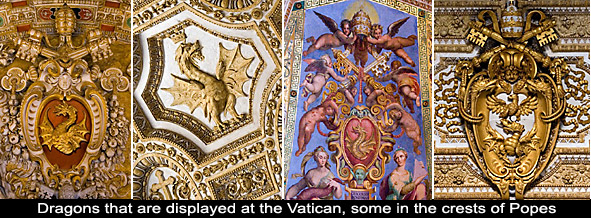
Ask yourself, why does the Catholic Church use images of the dragon which represents Satan?
Friend, it’s obvious that the Roman Catholic Church is worshiping other gods, which is forbidden by the Bible.
God’s 1st commandment says “You shall have no other gods before Me.” Exodus 20:3
The Roman Catholic Church and the Pope have fulfilled many Bible prophecies, as the antichrist beast of Revelation.
Read this study to learn the truth: What The Bible Says About The Roman Catholic Church
References:
https://en.wikipedia.org/wiki/Obelisk
https://en.wikipedia.org/wiki/List_of_obelisks_in_Rome
https://en.wikipedia.org/wiki/Archbasilica_of_St._John_Lateran
https://en.wikipedia.org/wiki/Basilica_di_Santa_Maria_Maggiore
https://en.wikipedia.org/wiki/Pigna_%28rione_of_Rome%29
http://www.whale.to/c/churches_ill.html#Zucchettos__
Maltese https://www.britishmuseum.org/explore/highlights/highlight_objects/me/s/stela_of_shamshi-adad_v.aspx
All-seeing eye: http://www.whale.to/c/churches_ill.html#Maltese_Cross_

It’s about being honest, David. It’s not about debating quotes, it’s about misquoting, taking quotes out of context, and fabricating them to “prove” … what?
You claim I argue about little things? You present quotes to prove your points and when I show they’re wrong, they become little things? If they were so little, why did you bring them up in the first place? They’re your points, not mine, your “quotes,” not mine. What’s little is misquoting, editing, and fabrication. THAT’S little.
You “prove” nothing. Over and over and over again. It’s virtually impossible to read your stuff since it’s replete with errors. For example, in your first link above, you state “Satan was enraged and he increased the severity of the persecution of the saints, to try to wipe out the early church; killing 10 million saints, during 10 periods of persecution period.” In reality, estimates range from 10,000 to 100,000 Christians actually martyred before 313 AD. There have been more Christians martyred in the last 100 years than in the entirety of preceding time back to the death of Christ.
And that’s just one example. How does one slog through fabrication after fabrication like this?
And then, you have the temerity to assert this: Many of her Cardinals, Bishops and priests, are gay and pedophiles. And earlier this: Your church is full of gay priests and pedophiles.
According to the American Psychiatric Association’s Diagnostic and Statistical Manual of Mental Disorders-IV, pedophilia is sexual attraction to children who have not yet arrived at puberty (DSM-IV, 528). While there have been priests who were pedophiles, the overwhelming majority of cases involved a disorder called ephebophilia, a term that refers to sexual attraction to minors who have arrived at puberty (i.e., teenagers). But we shouldn’t give a false emphasis to the clinical term ephebophilia, because it masks the real nature of what is occurring: priestly homosexual activity with under-aged males.
The overwhelming majority of the priests involved in these incidents are accused of sexual molestation of adolescent males, not females. This means that nature of the scandal is homosexual. It’s not predominantly pedophilia as you want to imply. But then, it’s much easier to say “pedophilia priests” than “ephebophilia priests,” isn’t it? More catchy…
Many? Full? Really? As reported by the Associated Press before the Bishops convened in June of 2002 to address this problem, there were 250 document cases of sexual abuse. But there are 47,000 priests in the US. That means that less than 0.54% (that’s 0.0054) have been involved.
You’re going to say there’s more since 2002? Want to triple that number? Heck, lets increase it by a factor of 10 just to make you happy. That’s 2500 cases. That would only be 5.4%. Hardly many, hardly full, as you claim.
What happened is horrible. It sickens me. I’m in no way trying to condone or excuse what happened. But since you brought the subject up, I feel obligated to respond with facts and reason.
BTW, the U.S. Department of Health and Human Services, Administration for Children and Families report “Child Maltreatment 2006” states that sexual abuse by Catholic clergy was less than one-half of one percent of all cases.
The report states that the perpetrators relationship to the victim was:
29.1% were Other Relatives
26.2% were Parents
24.4% were Others
6.9% were Unknown or Missing People
6.1% were Unmarried Partners of Parent
4.4% were Friends or Neighbors
1.8% were Child Daycare Providers
0.5% were Other Professionals
0.3% were Foster Parents
0.3% were Residential Facility Staff
0.1% were Legal Guardians
So even 4 years after the 2002 data, the percentage was still less than 0.5%.
Are popes corrupt? You betcha! So are bishops and priests. I never once stated they weren’t. There have been some real nasty ones. But the actions of some does nothing to invalidate the office they hold or the Church the represent any more than the actions of corrupt politicians, including presidents, invalidate the office, or even the country they represent.
So there it is, David. As long as you continue to post stuff like this, I’m going to continue to hang around and prove you’re wrong. Not that I think I can change your mind, but maybe some poor soul will read this and see what you’re doing. It’s my penance, my cross, and I gladly pick it up.
It’s about being honest? Really? I’ve given you ample proof that the Popes of Rome fulfill Bible prophecy as the Little Horn of Daniel 7, the Son of Perdition of 2 Thessalonians 2 and the antichrist of Revelation; yet here you are pointing out that priests mostly raped teenagers, not children. Seriously?
I’m not going to spend my time debating about the little things, like the quotes. I cited my sources, and you post alternative explanations, because the Catholic Church has created them, to cover over the fact that the Popes banned and burned the Scriptures; and caused millions of saints to be killed.
The long record of the testimony of the saints, many of which were killed by the Popes of Rome; stands in directly contrast to anything you have to say. http://revelationtimelinedecoded.com/historic-witnesses-against-the-antichrist-beast-the-popes-of-rome/
When I say that the Catholic Church is full of gay priests and pedophiles; it’s merely pointing to the many thousands of cases against them, causing them to spend billions in payouts. And that is only from the people who have dared to report the crimes. Goodness knows how many children have been raped by priests, who were too scared to say anything.
Post all you want, argue all you want. I will just point you back to the elephant in the room, that the Popes are the Satan-empowered enemy of Messiah and His saints; who leads the harlot Catholic Church, which is based on the Babylonian Mystery religion.
Every time you post, I will provide links to the studies; so that Catholics who are sincerely looking for the truth, can find it.
Prophecy Points To The Leader Of The Roman Beast http://revelationtimelinedecoded.com/prophecy-points-to-the-leader-of-the-roman-beast/
Prophecy Points To The Roman Catholic Church http://revelationtimelinedecoded.com/prophecy-points-to-the-roman-catholic-church/
What, so you’re quoting protestants as proof that your your supposed bible studies are valid? Wow, that a big surprise. Because, you know, one can always count on a fair and balanced result when one uses only one side to present “facts.”
You prove my point, David. It’s all one sided.
All of those saints are proclaiming that the office of the papacy is the Son of Perdition and the antichrist beast, and that the Roman Catholic Church is the harlot church of Revelation 17; and yet, you ignore their witness!
But I also cite Catholic witnesses:
Cardinal Bellarmine said: “Rome is signified in the Apocalypse by the name of Babylon.“
Cardinal Baronius said: “All persons confess that Rome is denoted by the name Babylon in the Apocalypse of John.”
A top Apologist for the Roman Catholic Church, Karl Keating, emphatically states:
“Babylon is a code word for Rome. It is used that way six times in the last book of the Bible” [four of the 6-times used, are in chapters 17-18 and in extra-biblical works such as Sibylling Oracles (5, 159f), the Apocalypse of Baruch (ii, 1), and 4 Esdras (3:1).
Revered Cardinal Gibbons of the Roman Catholic Church stated:
“The penetration of the religion of Babylon became so general and well known that Rome was called the New Babylon” – Faith of our fathers 1917 ed. Cardinal Gibbons, p. 106
Revered Cardinal Newman of the Roman Catholic Church admits in his book that;
the “temples, incense, oil lamps, votive offerings, holy water, Holidays, seasons of devotion, processions, blessings of the fields, sacerdotal vestments, the tonsure (of priests, monks, nuns), images, and statues… are all of PAGAN ORIGIN” – The Development of the Christian Religion Cardinal Newman p.359
Augustine proclaimed Rome as Babylon;
“Rome, the second Babylon, and the daughter of the first, to which it pleased God to subject the whole world, and bring it all under the sovereignty, was not founded.” (City of God, book xviii., chapt. xxii)
“Cardinal Bellarmine said: “Rome is signified in the Apocalypse by the name of Babylon.“
Cardinal Baronius said: “All persons confess that Rome is denoted by the name Babylon in the Apocalypse of John.””
Source these supposed quotes, please. Web searches all point to protestant sites, but no sites that lists these as actual quotes from Bellarmine.
A top Apologist for the Roman Catholic Church, Karl Keating, emphatically states:
“Babylon is a code word for Rome. It is used that way six times in the last book of the Bible” [four of the 6-times used, are in chapters 17-18 and in extra-biblical works such as Sibylling Oracles (5, 159f), the Apocalypse of Baruch (ii, 1), and 4 Esdras (3:1).”
I’m sure he did. But in context, he was referring to Rome at the time of Peter and Paul.
“Revered Cardinal Newman of the Roman Catholic Church admits in his book that;
the “temples, incense, oil lamps, votive offerings, holy water, Holidays, seasons of devotion, processions, blessings of the fields, sacerdotal vestments, the tonsure (of priests, monks, nuns), images, and statues… are all of PAGAN ORIGIN” – The Development of the Christian Religion Cardinal Newman p.359”
To answer this allegation, I will reference a response by another person on this web site: https://answers.yahoo.com/question/index?qid=20090307115344AA5VBAr
The work you are referring to is actually titled “An Essay On The Development of Christian Doctrine.”
The quote that you incorrectly paraphrased is on page 374 not on page 359 and is pasted below.
“The example set by St. Gregory in an age of persecution was impetuously followed when a time of peace succeeded. In the course of the fourth century two movements or developments spread over the face of Christendom, with a rapidity characteristic of the Church; the one ascetic, the other ritual or ceremonial. We are told in various ways by Eusebius [Note 16], that Constantine, in order to recommend the new religion to the heathen, transferred into it the outward ornaments to which they had been accustomed in their own. It is not necessary to go into a subject which the diligence of Protestant writers has made familiar to most of us. The use of temples, and these dedicated to particular saints, and ornamented on occasions with branches of trees; incense, lamps, and candles; votive offerings on recovery from illness; holy water; asylums; holydays and seasons, use of calendars, processions, blessings on the fields; sacerdotal vestments, the tonsure, the ring in marriage, turning to the East, images at a later date, perhaps the ecclesiastical chant, and the Kyrie Eleison [Note 17], are all of pagan origin, and sanctified by their adoption into the Church. {374}”
Nowhere in the Bible does it say that any of the things mentioned are in and of themselves “evil” or forbidden and Newman concludes by saying that all of these things are “sanctified by their adoption into the Church”.
CAVEAT: Of the Pagan rituals listed above by Newman, Protestants have incorporated the following;
Churches (aka temples)
Holidays (Christmas, Easter, Advent, Lent)
Seasons (Winter, Spring, Summer, Fall)
Calendars
Processions (The Walk For Life etc)
Blessings (Annointing of the Sick, Praying over people, Ordination)
Vestments (Gowns, Robes and Saches)
Wedding Rings
Images (Crosses, Spinning Globes [Joel Osteen] , Doves[Calvary Chapel], Flames, Candles, Wings etc)
Rituals (The Altar Call, The Sinners Prayer, Being Drunk in the Spirit, Speaking in Tongues, the “Toronto Blessing” etc)
Ecclesial Chants (Amazing Grace, How Great Thow Are, Soon and Very Soon)
Pagans also ate food and drank water and married and had children, does that make eating and drinking and marrying and having children evil? Should Christians not eat or drink or marry or have children because Pagans also did these things? Newman was simply pointing out an historical fact. Newman was a Priest in the Anglican (Church of England) church who ended up converting to Catholicism after studying church history.
““Rome, the second Babylon, and the daughter of the first, to which it pleased God to subject the whole world, and bring it all under the sovereignty, was not founded.” (City of God, book xviii., chapt. xxii)”
What Augustine ACTUALLY wrote:
CHAPTER 22 THAT ROME WAS FOUNDED WHEN THE ASSYRIAN KINGDOM PERISHED, AT WHICH TIME HEZEKIAH REIGNED IN JUDAH
To be brief, the city of Rome was rounded, like another Babylon, and as it were the daughter of the former Babylon, by which God was pleased to conquer the whole world, and subdue it far and wide by bringing it into one fellowship of government and laws. For there were already powerful and brave peoples and nations trained to arms, who did not easily yield, and whose subjugation necessarily involved great danger and destruction as well as great and horrible labor. For when the Assyrian kingdom subdued almost all Asia, although this was done by fighting, yet the wars could not be very fierce or difficult, because the nations were as yet untrained to resist, and neither so many nor so great as afterward; forasmuch as, after that greatest and indeed universal flood, when only eight men escaped in Noah’s ark, not much more than a thousand years had passed when Ninus subdued all Asia with the exception of India. But Rome did not with the same quickness and facility wholly subdue all those nations of the east and west which we see brought under the Roman empire, because, in its gradual increase, in whatever direction it was extended, it found them strong and warlike. At the time when Rome was rounded, then, the people of Israel had been in the land of promise seven hundred and eighteen years. Of these years twenty-seven belong to Joshua the son of Nun, and after that three hundred and twenty-nine to the period of the judges. But from the time when the kings began to reign there, three hundred and sixty-two years had passed. And at that time there was a king in Judah called Ahaz, or, as others compute, Hezekiah his successor, the best and most pious king, who it is admitted reigned in the times of Romulus. And in that part of the Hebrew nation called Israel, Hoshea had begun to reign.
Clearly, Augustine was referring to a time LONG before the Catholic Church.
David, do you actually read this stuff before you quote it?
These witnesses testified against the Popes of Rome before the Protestant Reformation. http://revelationtimelinedecoded.com/historic-witnesses-against-the-antichrist-beast-the-popes-of-rome/
Arnulf (991), the Bishop of Orleans, proclaimed the Pope as the Antichrist, sitting in the temple of God, and showing himself as God.
“deplored the roman popes as “monsters of guilt” and declared in a council called by the King of France in 991 A.D. that the pontiff, clad in purple and gold, was, “Antichrist, sitting in the temple of God, and showing himself as God.” (Phillip Schaff, History of the Christian church, 8 vols., reprint of the 3d (1910)ed. (Grand Rapids Mich.: Wm. B Eerdmans Publishing Co., n.d.)
Gherbert of Rheims said that the Pope was the antichrist sitting in the temple of God.
Before the year 1000, Gherbert said of the pope sitting on his lofty throne in gold and purple, that if destitute of charity, he was antichrist sitting in the temple of God.
Berenger said the Roman see to be not the apostolic seat, but the seat of Satan.
In the eleventh century, referring to the Pope’s enforcement at that time of the doctrine of transubstantiation, Berenger affirmed the Roman see to be not the apostolic seat, but the seat of Satan.
Eberhard II (1240), archbishop of Salzburg, affirmed that the Pope was the antichrist.
“Stated at a synod of bishops held at Regensburg in 1240 that the people of his day were “accustomed” to calling the pope antichrist.” (LeRoy Edwin Froom, The Prophetic Faith of our Fathers)
The early witnesses were people groups called the Albigenses and Waldenses (called Vaudois in French).
God had entrusted them with preserving His Holy Word, which is why the Papal Church persecuted them so relentlessly.
The Albigenses called the Church of Rome the whore of Babylon.
In the sunny south of France, in Provence and Catalonia, lived the Albigenses, who were bible-believing followers of Christ.
The Albigensian Christians preached against the immoralities of the Roman Catholic priesthood, pilgrimages, worship of saints and idols, opposed the (pompous and pretentious) claims of the Church of Rome; and made great use of the Scriptures. By 1167 they (the Albigensian Christians) were a majority of the population of South France.
The Albigenses “All agreed in regarding the Church of Rome as having absolutely perverted Christianity, and in maintaining that it was she who was designated in the Apocalypse by the name of the whore of Babylon.”
Rome could not endure this testimony; she drew her deadly sword and waged war against those who bore it. The Albigensian Crusade (1209–1229) was a 20-year military campaign initiated by Pope Innocent III to eliminate the Albigenses in the south of France.
In 1229 – The Roman Catholic Inquisition executed 32,000 Bible-believing Albigensian Christians at Toulouse, France – and confiscated all their property!
By the time the Roman Catholic armies finished these “crusades”, almost the entire population of southern France (mostly Albigensian Christians) had been exterminated.
The Waldenses called the Roman Church the harlot of Babylon, and the Papacy, the “man of sin” and “antichrist”.
Peter Waldo (1140-1218) was a rich merchant of Lyons, France, who gave up everything to preach the Gospel. Waldo’s followers called themselves “the Poor in Spirit“.
The Waldensians were orthodox in their beliefs, but they were outside of the organizational structure of the Roman Catholic Church. They traveled in pairs, preaching the Gospel. They were humble people who believed in “apostolic poverty”. They were barefoot, owning nothing, and they shared all things in common.
They were considered to be a threat because they set standards which made many members of the Catholic clergy look bad by comparison. In 1184, Pope Lucius III excommunicated Waldo and his followers.
They were students of prophecy from the oldest times. In the book of Waldensian Pastor Leger called “Treatise on Antichrist” written in 1120, said “That treatise brands the Romish Church as the harlot Babylon, and the Papacy as the “man of sin” and antichrist.”
Waldensian Reinerius Saccho asserted “that the Romish church is not the church of Jesus Christ, but a church of malignants and that it apostatized under Sylvester—and that the Church of Rome is the harlot in the apocalypse.” (The Testimony of The Reformers, E. Bickersteth, 1836, p. 46 from the Testimony of Reinerius Saccho, in 1254)
That was the faith and confession of the Waldenses, for which they were killed by the Papal Church.
“Whereupon we, with all our posterity, have to understand what be the reasons and arguments wherewith the antichrist of Rome is wont to uphold the impious seat of his abomination; who now is come to such excess and profundity of all kinds of iniquity, that all justice, equity, and verity being set aside, he seeketh the defence of his cause by no other thing than only by force and violence, terror and oppression, and shedding of blood.” Foxes Book of Martyrs: The Waldensian martyrs in Provence
Where not a few persons, but whole villages and townships, with the most part of all the aforesaid country, both men, women, and children, were put to all kinds of cruelty, and suffered martyrdom for the profession of the gospel.
The history of the persecutions and wars against the people called Waldenses or Waldois, in the valleys of Angrogne, Lucerne, St. Martin, Perouse, and others, in the country of Piedmont, from A.D. 1555, to A.D. 1561.
“For who would ever have judged or suspected in his mind, that the bishop of Rome (commonly received, and believed, almost of all men, to be the vicar and vicegerent of Christ here in earth) to be antichrist, and the great adversary of God, whom St. Paul so expressly prophesieth of, in these latter days to be revealed by the brightness of the Lord’s coming, as all men now, for the most part, may see it is come to pass?” Foxes Book of Martyrs: The Waldensian martyrs of Peidmont
Michal of Cesena declared the Church of Rome to be the Whore of Babylon.
Michal (1270-1342) who came out of the Franciscan Order of the Catholic Church declared the Pope “to be Antichrist, and the church of Rome to be the whore of Babylon, drunk with the blood of the saints.” Foxes Book of Martyrs, op cit., p. 445
John Wycliffe said Antichrist, the head of all these evil men, is the pope of Rome.
John, (1330-1384), called the Morning Star of the Reformation, spent most of his life teaching at Oxford University and was recognized by John of Guant (The Duke of Lancaster) as extraordinarily gifted in theology. He translated the Latin Vulgate Bible into English and placed it in the hands of the people.
Wycliffe said of the Pope:
“When the western church was divided for about 40 years between two rival popes, one in Rome and the other in Avigon, France, each pope called the other pope antichrist – and John Wycliffe is reputed to have regarded them as both being right: “two halves of Antichrist, making up the perfect Man of Sin between them.”
“We suppose that Antichrist, the head of all these evil men, is the pope of Rome.” (Ibid, p. 90)
40 years after his death the Roman Catholic Church dug up his bones and had them burned and the ashes were thrown into the river.
Walter Brute was martyred for saying the Pope is the Antichrist.
Walter was a noted scholar, prophetic expositor and associate of Wycliffe.
In 1391 he was accused of saying the pope is antichrist, and a seducer of the people, and utterly against the law and life of Christ, and he was killed for his testimony
Matthias of Janow said the Pope is the most wicked Christian, falsely styling himself by that name.
Matthias was a fourteenth-century Bohemian ecclesiastical writer. Matthias came to be known as the Bohemian Wycliffe. He received his doctorate from the University of Paris and in 1381 became the canon in the Cathedral of Prague. His writings paved the way for the Hussite movement.
Janow based his conclusions about the Antichrist on II Thessalonians 2, Daniel 7 and Revelation 13 and 17. Here is one of his statements:
“The Antichrist has already come. He is neither Jew, pagan Saracean nor worldly tyrant, but the ‘man who opposes Christian truth and the Christian life by way of deception;—he is, and will be, the most wicked Christian, falsely styling himself by that name, assuming the highest station in the church, and possessing the highest consideration, arrogating dominion over all ecclesiastics and laymen;’ one who, by the working of Satan, assumes to himself power and wealth and honor, and makes the church, with its goods and sacraments, subservient to his own carnal ends.” Froom, PFF, volume 2, p. 40.
John Purvey said the Papacy was the kingdom of the Antichrist.
John (1354 – 1414) was one of the leading followers of the English theologian and reformer John Wycliffe during the late fourteenth and early.
Luther said “We are not the first who interpret the Papacy as the kingdom of Antichrist…He (John Purvey in 1390 AD) rightly and truly pronounces the Pope “Antichrist” as he is…a witness indeed, foreordained by God to confirm our doctrine.” (Martin Luther, Commentarius in Apocalypsin reprint).
Sir John Oldcastle, a follower of Wycliffe, proclaimed the Pope as the great Antichrist, the Son of Perdition, the open Adversary of God, and the Abomination standing in the holy place.
John (died in 1417) was an English Lollard leader, who was also known as Lord Cobham, was knight of Herefordshire, and a prominent follower of Wycliffe. He unequivocally stated:
“But as touching the Pope and his Spirituality, I owe them neither suit nor service, for so much as I know him by the Scriptures to be the great Antichrist, the Son of Perdition, the open Adversary of God, and the Abomination standing in the holy place.” (Froom, PFF, volume 2, p. 88.)
Being a friend of Henry V, he long escaped prosecution for heresy.
He spoke of the Pope in these words: “I know him by the scriptures to be the great Antichrist, the son of Perdition… Rome is the very nest of Antichrist, and out of that nest come all the disciples of him.“ Guinness, op. cit., p. 134
When convicted, he escaped from the Tower of London and then led a rebellion against the King. Eventually, he was captured and executed in London. For his testimony King Henry V had him “hanged up by the middle, in chains of iron, and so consumed alive in the fire, praising the name of God as long as his life lasted.”(Ibid., pp. 636-641)
William White said that the pope… is nothing else but a devilish estate and heavy yoke of antichrist, and therefore he is an enemy unto Christ’s truth.
William was a follower of John Wycliffe, and he was well learned, upright, and a well-spoken priest.
“That the wicked living of the pope, and his holiness, is nothing else but a devilish estate and heavy yoke of antichrist, and therefore he is an enemy unto Christ’s truth.”
John Huss proclaimed the Antichrist has been revealed in the Pope for which he was burned to death.
John Huss (a.k.a. Jan Huss, 1372-1415) was a well-educated man from Bohemia, who came under the influence of Wycliffe’s writings, which caused him to break with the church of Rome.
A reformation sprang up in Southern Bohemia, a province in NW Africa, more than a century before the time of Luther, and was quenched in seas of blood. What gave rise to it? The testimonies of John Huss and Jerome of Prague. His followers became known as Hussites.
He referred to the Antichrist as the enemy of the Church – not as a Jew, a pagan, or a Turk(Muslim) – but as a false confessor of the name of Christ.
“Surely even at this day is the malice, the abomination, and filthiness of ANTICHRIST revealed in the pope…”
“The Pope is … the true Antichrist, of whom it is written, that he sitteth in the temple of God, among the people where Christ is worshiped…”
“I trust in God that He will send after me those that shall be more valiant; and there are alive at this day that shall make more manifest the malice of ANTICHRIST, and shall give their lives to the death for the truth of our Lord Jesus Christ.”
Among his dying words he proclaimed, “In 100 years, God will raise up a man whose calls for reform cannot be suppressed.”
The name “Huss” meant goose in the Bohemian language, and he said “This day ye are burning a goose; but from my ashes will arise a swan, which ye will not be able to roast.”
Almost exactly 100 years later, in 1517, Martin Luther nailed his famous 95 Theses of Contention (a list of 95 issues of heretical theology and crimes of the Roman Catholic Church) onto the church door at Wittenberg. The prophecy of John Hus had come true!
He was condemned as a Heretic by the Catholic Church and was burned to death by a bonfire made up of his books on July 6, 1415. He died singing to the Lord. His ashes were gathered and cast into the nearby Rhine River.
Jerome of Prague was burned at the stake for his testimony against the Roman Catholic Church.
Jerome of Prague (Jeroným Pražský in Czech, 1379 – 30 May 1416) was a Czech church reformer and one of the chief followers of Jan Hus who was burned for heresy at the Council of Constance.
The Roman Catholic Church accused him of the following: 1. That he was a derider of the papal dignity. 2. An opposer of the pope. 3. An enemy to the cardinals. 4. A persecutor of the prelates. 5. A hater of the Christian religion.
In going to the place of execution he sang several hymns, and when he came to the spot, which was the same where Huss had been burnt, he knelt down, and prayed fervently. He embraced the stake with great cheerfulness, and when they went behind him to set fire to the fagots, he said, “Come here, and kindle it before my eyes; for if I had been afraid of it, I had not come to this place.” The fire being kindled, he sang a hymn, but was soon interrupted by the flames; and the last words he was heard to say these, “This soul in flames I offer Christ, to Thee.”
John Purvey rightly and truly pronounced the Pope as Antichrist.
John (1354-1428), who was a close associate of John Wycliffe, published a commentary on the Apocalypse in 1390 based on Wycliffe’s sermons.
Over one hundred years later, a copy of this book came into the hands of Martin Luther who was so impressed by it that he reprinted it in Wittenberg in 1528 describing it as “a Commentary on the Apocalypse Written 100 Years Ago.”
Purvey’s Commentarius in Apocalypsin [Commentary on the Apocalypse] was prefaced by this impressive statement by Martin Luther:
“This preface, noble reader, you may understand was written by us for this reason—that we might make known to the world that we are not the first who interpret the Papacy as the kingdom of Antichrist. For many years prior to us, so many and so great men (whose number is large, and their memory eternal) have attempted this so clearly and openly, and that with great spirit and force, that [those] who were driven by the fury of the papal tyranny into the farthest boundaries of the earth, and suffering the most atrocious tortures, nevertheless bravely and faithfully persisted in the confession of the truth. Although we in this age are far more learned and free than they, yet we ought to be ashamed that they, held in great barbarity and captivity, were so much braver and bolder than we in spirit and fortitude.”
“For as this author was, for his age (as I think), among the first who sought learning and holiness most ardently, yet hindered by the defectiveness of the time and the reign of darkness could neither speak these things so purely nor think so clearly as in this our age we speak and think, yet he rightly and truly pronounces the Pope Antichrist, (as he is). . ..a witness, indeed, foreordained by God to confirm our doctrine.” Froom, PFF, volume 2, pp. 94-95.
AS YOU CAN CLEARLY SEE, IT’S NOT JUST MY OPINION!!! AND IT’S NOT JUST THE PROTESTANT REFORMERS!!! HOW CAN YOU IGNORE THEIR WITNESS? UNLESS YOU ARE A DECEIVER, WHO ISN’T LOOKING FOR TRUTH!!!
so david trying to prove that the mother church is pagan or worship false Gods. am i correct
Jason, here is a Bible study that proves how the Roman Catholic Church fulfills Bible prophecy. http://revelationtimelinedecoded.com/prophecy-points-to-the-roman-catholic-church/
And here is a Bible study that proves how the Popes and Jesuit General fulfill Bible prophecy. http://revelationtimelinedecoded.com/prophecy-points-to-the-leader-of-the-roman-beast/